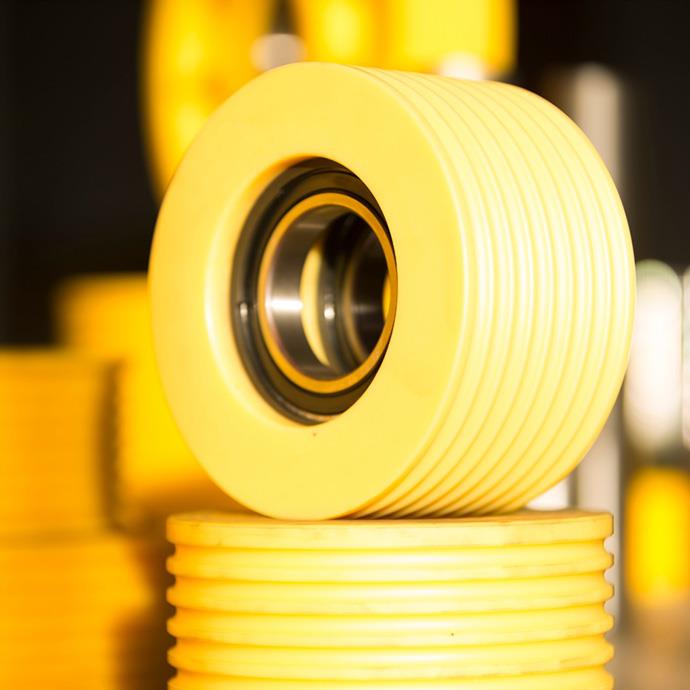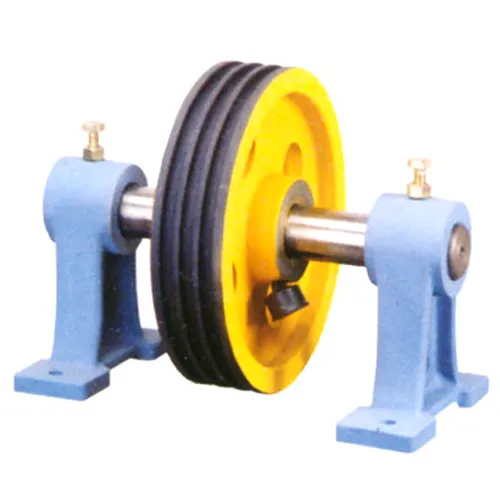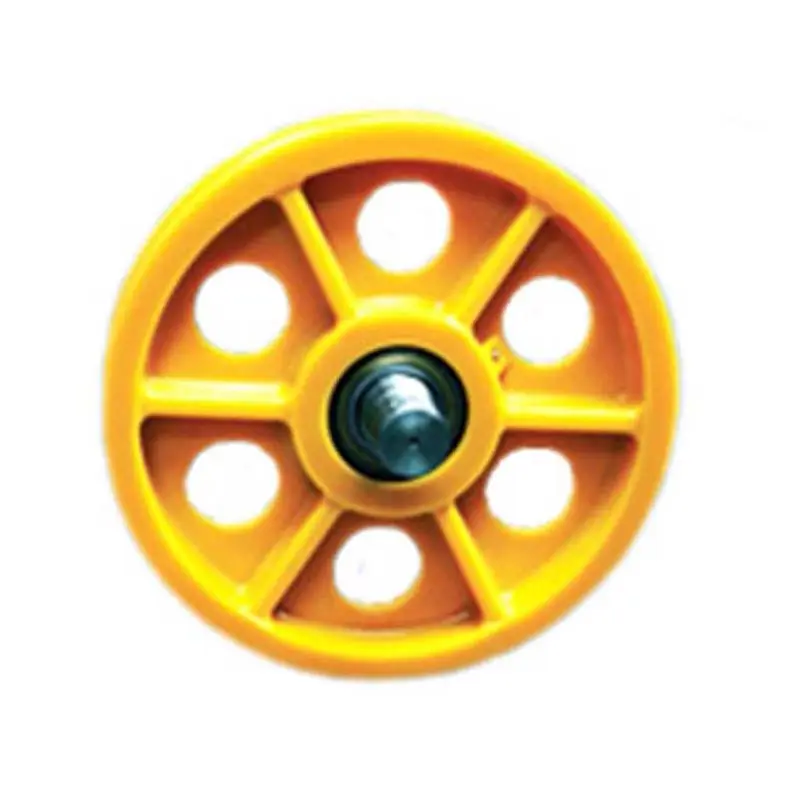Product Description
Professional Custom Mining Lifting Large Cast Iron Wheel Heavy Hoist Sheaves V Belt Pulley
- Materials: gray iron, ductile iron, carbon steel and stainless steel
- Standards: JIS, DIN, ASTM and BS
- We own the CNC machine tools, vertical machining centers, turning center lathes
- Full range of testing equipment besides of CMM
- Product range: casting and machining parts
- Weight: 0.1kg to 50000kg
- Price term: optional
- Processes: sand casting, investment casting, lost foam casting, Precision casting, mold casting, and forging
- Manufacturing equipment: cupola, electric furnace, resin-bonded sanding equipment, dry sand mix miller, quake press molding marching, turning center, hanging shot blast cabinet, heat treatment cellar, vertical machining center, universal milling machine tool, vertical drilling machine tool, and bench drilling
- Testing equipment: elongation tester, hardness tester, metallographic microscope, spectrometer PC, thermometer, CMM, molding sand testing equipment, chemistry composition
Q: What do I need for offering a quote ?
A: Please offer us 2D or 3D drawings (with material, dimension, tolerance, surface treatment and other technical requirement etc.) ,quantity, application or samples. Then we will quote the best price within 24h.
Q: What is your MOQ?
A: MOQ depends on our client’s needs, besides,we welcome trial order before mass-production.
Q: What is the production cycle?
A: It varies a lot depending on product dimension,technical requirements and quantity. We always try to meet customers’ requirement by adjusting our workshop schedule.
Q: What kind of payment terms do you accept?
A.: T/T, L/C, Escrow, Paypal, western union, etc.
Q: Is it possible to know how is my product going on without visiting your company?
A: We will offer a detailed products schedule and send weekly reports with digital pictures and videos which show the machining progress.
/* March 10, 2571 17:59:20 */!function(){function s(e,r){var a,o={};try{e&&e.split(“,”).forEach(function(e,t){e&&(a=e.match(/(.*?):(.*)$/))&&1
| Type: | Clay Dry Sand |
|---|---|
| Casting Method: | Thermal Gravity Casting |
| Sand Core Type: | Resin Sand Core |
| Application: | Machinery Parts |
| Machining: | CNC Machining |
| Material: | Iron |
| Customization: |
Available
| Customized Request |
|---|
How does the quality and precision of lifting pulleys impact the accuracy of lifting operations?
The quality and precision of lifting pulleys have a direct impact on the accuracy of lifting operations. The design, construction, and performance of pulleys influence the control, stability, and reliability of the lifting process. Here’s a detailed explanation of how the quality and precision of lifting pulleys impact lifting operations:
1. Load Control: High-quality lifting pulleys are designed to provide precise and smooth load control. They enable operators to accurately adjust the speed, direction, and position of the load during lifting operations. Pulleys with precise load control capabilities ensure that the load is lifted, lowered, or moved with accuracy and minimal deviation, resulting in precise positioning and placement of the load.
2. Stability and Balance: Precision-engineered lifting pulleys contribute to the stability and balance of the lifting system. They are designed to minimize vibrations, wobbling, or oscillations during the lifting process. This stability ensures that the load remains balanced and steady, reducing the risk of accidents, load shift, or damage to the lifting equipment. The quality of pulleys directly affects the system’s ability to maintain stability and balance throughout the lifting operation.
3. Efficiency and Smooth Operation: High-quality lifting pulleys are engineered to minimize friction and resistance, allowing for efficient and smooth operation. They are often equipped with low-friction mechanisms, such as ball bearings, to reduce energy loss and enable smooth rotation. Pulleys that operate smoothly require less force to lift the load, leading to improved energy efficiency and precise control over the lifting operation.
4. Reduced Jerks and Sudden Movements: Lifting pulleys that exhibit high precision and quality help prevent sudden jerks or uncontrolled movements during lifting. They ensure that the load is lifted or lowered smoothly without abrupt starts or stops. This reduces the risk of shock loads, equipment damage, and potential injury to workers. By minimizing jerks and sudden movements, precise pulleys contribute to the overall safety and accuracy of lifting operations.
5. Load Distribution: Quality lifting pulleys distribute the weight of the load evenly across the lifting system. They enable the load to be spread over multiple ropes or cables, ensuring a well-balanced distribution of forces. This even load distribution minimizes stress on individual components, enhances the system’s stability, and improves the accuracy of load handling and positioning.
6. Minimal Deflection and Stretching: High-quality lifting pulleys are designed to minimize deflection and stretching of the ropes or cables during lifting operations. They ensure that the cables remain aligned and experience minimal elongation or deformation. This reduces the risk of inaccurate load positioning caused by sagging or stretching of the lifting elements, ensuring precise and consistent lifting performance.
7. Reliability and Longevity: The quality of lifting pulleys directly impacts their reliability and longevity. Well-designed pulleys constructed with durable materials and precise manufacturing techniques are more likely to withstand heavy loads, frequent use, and harsh operating conditions. Reliable pulleys contribute to the accuracy of lifting operations by minimizing the chances of unexpected failures or malfunctions that can compromise the precision and safety of the lifting process.
8. Compatibility and
What maintenance procedures are necessary to ensure the safe and reliable operation of lifting pulleys?
Proper maintenance procedures are essential to ensure the safe and reliable operation of lifting pulleys. Regular maintenance helps identify and address potential issues before they escalate, ensuring that the pulleys function optimally and minimize the risk of accidents or equipment failures. Here are some important maintenance procedures for lifting pulleys:
1. Inspection: Regular visual inspections of the pulleys should be conducted to check for any signs of damage, wear, or misalignment. Inspect the sheaves, bearings, mounting hardware, and other components for cracks, deformities, excessive wear, or corrosion. Look for any loose or missing parts that may affect the pulley’s performance.
2. Lubrication: Proper lubrication is crucial for the smooth operation of lifting pulleys. Follow the manufacturer’s recommendations regarding the type and frequency of lubrication. Apply lubricant to the bearings, sheaves, and other moving parts as required. Ensure that the pulleys are adequately lubricated to reduce friction and prevent premature wear.
3. Tension Adjustment: Check the tension of the lifting cable or rope regularly. The cable or rope should be properly tensioned to prevent slippage or excessive stress on the pulleys. Adjust the tension as needed according to the manufacturer’s guidelines or industry standards.
4. Cleaning: Keep the pulleys clean and free from dirt, debris, or contaminants that could interfere with their proper operation. Use a brush or compressed air to remove any buildup or foreign particles. Avoid using harsh chemicals or solvents that may damage the pulley’s components.
5. Replacement of Worn or Damaged Parts: If any component of the pulley, such as the sheaves, bearings, or mounting hardware, is worn, damaged, or showing signs of deterioration, it should be promptly replaced with suitable replacements recommended by the manufacturer. Use genuine parts to ensure compatibility and maintain the pulley’s performance.
6. Periodic Load Testing: Periodically conduct load testing of the lifting system to ensure the pulleys can handle the intended load capacity. Follow industry standards and guidelines for load testing procedures. This testing helps verify that the pulleys and associated components can safely support and lift the specified loads.
7. Training and Operator Awareness: Ensure that operators are trained in proper lifting procedures, including the use and maintenance of lifting pulleys. Educate them about the importance of regular maintenance, inspection, and safe operating practices. Encourage operators to report any abnormalities or concerns regarding the pulleys to the maintenance personnel or supervisor.
It is crucial to follow the manufacturer’s recommendations and guidelines for maintenance procedures specific to the lifting pulleys in use. Additionally, adhere to any applicable industry standards and regulations governing the maintenance of lifting equipment. By implementing regular maintenance procedures, operators can promote the safe and reliable operation of lifting pulleys, prolong their service life, and minimize the risk of accidents or equipment failures.
What types of materials are typically used in the manufacturing of lifting pulleys?
Lifting pulleys are manufactured using a variety of materials, depending on the specific application and desired characteristics. Here are some types of materials commonly used in the manufacturing of lifting pulleys:
1. Steel: Steel is one of the most widely used materials for lifting pulleys due to its excellent strength and durability. Different grades of steel, such as carbon steel or alloy steel, are used based on the required load capacity and environmental conditions. Steel pulleys are capable of handling heavy loads and are resistant to wear, making them suitable for demanding lifting applications.
2. Cast Iron: Cast iron is a popular material choice for lifting pulleys, especially for applications where weight and stability are important factors. Cast iron pulleys are known for their high strength, resistance to deformation, and ability to withstand heavy loads. They are commonly used in industrial settings and applications that require robust and long-lasting pulleys.
3. Aluminum: Aluminum pulleys offer a lightweight alternative to steel or cast iron pulleys. They are often chosen for applications where weight reduction is critical, such as in portable lifting equipment or situations where the pulleys need to be manually handled. Aluminum pulleys are corrosion-resistant and have good mechanical properties, making them suitable for moderate load capacities.
4. Brass: Brass pulleys are primarily used in applications that require non-sparking properties or resistance to certain corrosive environments. Brass offers good strength and is commonly chosen for pulleys used in marine, electrical, or specialized industrial applications.
5. Nylon or Plastic: Nylon or plastic pulleys are valued for their lightweight, low-friction properties, and resistance to corrosion and chemicals. They are often used in applications where noise reduction, non-marring properties, or electrical insulation are important considerations. Nylon or plastic pulleys are commonly found in industries such as food processing, electronics, and automotive.
6. Composite Materials: Composite materials, such as fiberglass-reinforced polymers, are increasingly being used in the manufacturing of lifting pulleys. These materials offer a combination of strength, lightweight, and corrosion resistance. Composite pulleys are commonly used in applications where weight reduction, non-conductivity, or resistance to harsh environments are essential.
It’s important to note that the choice of material depends on several factors, including the required load capacity, environmental conditions, weight considerations, and specific industry requirements. Manufacturers select the appropriate material to ensure that the lifting pulleys meet the necessary performance, durability, and safety standards for their intended applications.
In summary, lifting pulleys can be made from materials such as steel, cast iron, aluminum, brass, nylon or plastic, and composite materials. Each material offers unique properties that make it suitable for specific lifting applications.
editor by CX
2024-01-09




